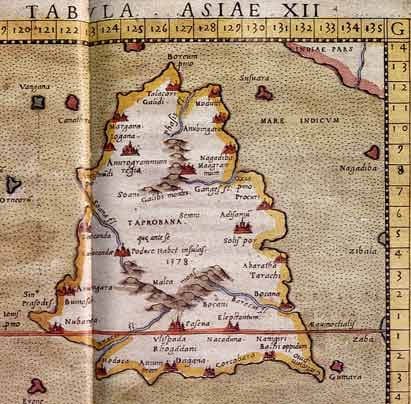|

Historical
Map of Sri Lanka
Sri Lanka's first settlers were the nomadic Veddahs. Legend
relates them to the Yakkhas, demons conquered by the Sinhalese
around the 5th or 6th century BC. A number of Sinhalese kingdoms,
including Anuradhapura in the north, took root across the
island during the 4th century BC. Buddhism was introduced
by Mahinda, son of the Indian Mauryan emperor Ashoka, in the
3rd century BC, and it quickly became the established religion
and the focus of a strong nationalism. Anuradhapura was not
impregnable. Repeated invasions from southern India over the
next 1000 years left Sri Lanka in an ongoing state of dynastic
power struggles.
The Portuguese arrived in Colombo in 1505 and gained a monopoly
on the invaluable spice trade. By 1597, the colonizers had
taken formal control of the island. However, they failed to
dislodge the powerful Sinhalese kingdom in Kandy which, in
1658, enlisted Dutch help to expel the Portuguese. The Dutch
were more interested in trade and profits than religion or
land, and only half-heartedly resisted when the British arrived
in 1796. The Brits wore down Kandy's sovereignty and in 1815
became the first European power to rule the entire island.
Coffee, tea, cinnamon and coconut plantations (worked by Tamil
laborers imported from southern India) sprang up and English
was introduced as the national language.
Then known as Ceylon in History, Sri Lanka finally achieved
full independence in 1948. The government adopted socialist
policies, but promoted Sinhalese interests, making Sinhalese
the national language and effectively reserving the best jobs
for the Sinhalese, partly to address the imbalance of power
between the majority Sinhalese and the English-speaking, Christian-educated
elite. It prompted the Tamil Hindu minority to press for greater
autonomy in the main Tamil areas in the north and east.
The country's ethnic and religious conflicts escalated as
competition for wealth and work intensified. When Bandaranaike
was assassinated in 1959 tryingto reconcile the two communities,
his widow, Sirimavo, became the world's first female prime
minister. She continued her husband's socialist policies,
but the economy went from bad to worse. A Maoist revolt in
1971 led to the death of thousands. One year later, the country
became a republic and made Sri Lanka its official name.
In 1972 the constitution formally made Buddhism the state's
primary religion, and Tamil places at university were reduced.
Subsequent civil unrest resulted in a state of emergency in
Tamil areas. Sinhalese security forces faced off against young
Tamils, who began the fight for an independent homeland. Junius
Richard Jayewardene was elected in 1977 and promoted Tamil
to the status of a 'national language' in Tamil areas. He
also granted Tamils greater local government control, but
violence escalated.
When Liberation Tigers of Tamil Eelam (LTTE) secessionists
massacred an army patrol in 1983, Sinhalese mobs went on a
two-day rampage, killing several thousand Tamils and burning
and looting property. This marked the point of no return.
Many Tamils moved north into Tamil-dominated areas, and Sinhalese
began to leave the Jaffna area. Tamil secessionists claimed
the northern third of the country and the eastern coast. They
were clearly in the majority in the north but proportionately
equal to the Sinhalese and Muslims in the east. Violence escalated
with both sides guilty of ethnic cleansing.
By 1985, there were 50,000 internal refugees, 100,000 Tamil
exiles in India, no tourism, slumping tea prices and dwindling
aid (because of human rights abuses). Government gains in
1987 led to Tamil unrest in India, prompting concerns of an
Indian invasion. The two governments agreed that the Sri Lankan
Army would retreat and an Indian Peace Keeping Force (IPKF)
would maintain order in the north and disarm the Tigers. The
agreement led to Sinhalese and Muslim riots in the south over
the government 'sell-out' and Indian 'occupation'. Sri Lanka
became a quagmire of inescapable violence.
A 1989 Sinhalese rebellion broke out in the south and the
Marxist JVP orchestrated a series of strikes and political
murders. The country was at a standstill. When the government's
talks with the JVP failed, it unleashed death squads that
killed JVP suspects and dumped their bodies in rivers. A three-year
reign of terror resulted in at least 30,000 deaths. The IPKF
withdrew in 1990. The Tigers had agreed to a ceasefire but
violence flared almost immediately when a breakaway Tamil
group unilaterally declared an independent homeland.
Rajiv Gandhi was assassinated by a Tamil suicide bomber in
1991 and Premadasa suffered the same fate in 1993. Chandrika
Bandaranaike Kumaratunga became prime minister in 1994, and
president in 1995, and for the second time her mother Sirimavo
Bandaranaike became prime minister.
Chandrika Kumaratunga won a second term in office in December
1999. Days before the vote, the president and People's Alliance
coalition leader was the target of a LTTE suicide bomb attack
in which she lost the sight in one eye. In December 2001,
Ranil Wickramasinghe, who lost the 1999 elections, became
prime minister when the United National Party swept parliamentary
elections. This could have led to deadlock between Parliament
and the executive in dealing with high inflation, high unemployment,
poor infrastructure and, of course, the 18-year-old civil
war, but unexpectedly promising peace talks with the LTTE
have facilitated cooperation in the political process.
Peace talks brokered by a Norwegian delegation inspired a
one-month cease-fire beginning 24 December 2001 (the first
in seven years), renewed in January 2002. With the lifting
of a seven-year-old embargo on LTTE-controlled territory,
it seems peace is not a pipe dream.
Historical Kings and Queens of Sri Lanka
|





 Whatsapp Support:
Whatsapp Support: